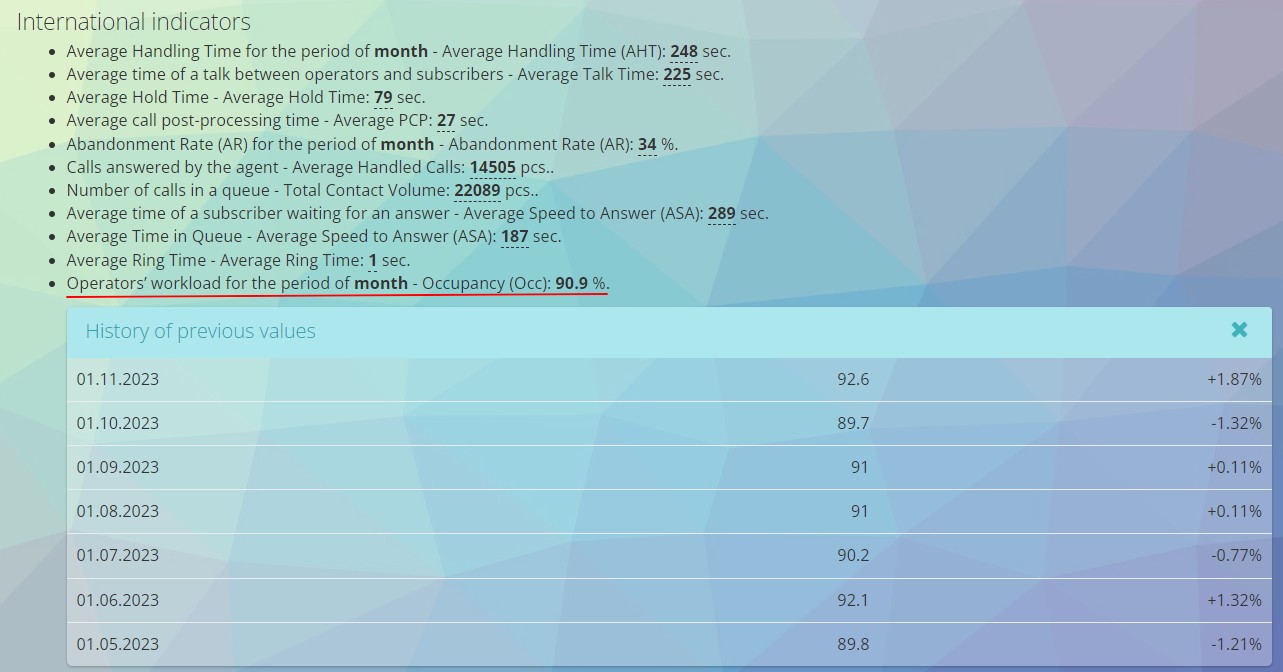ACW, also known as Post Call Processing (PCP), is the time that an agent spends after a call filling out forms, updating client records, or performing other tasks. Literally, this means “work after the call,” when the agent processes information obtained during the conversation with the client before taking a new call.
Although the client does not participate in this stage, ACW is part of the interaction and is therefore included in the overall call handling volume. The agent’s daily schedule will look like this:

What determines the duration of ACW?
The time typically taken for ACW can vary depending on the call center operation conditions. Usually, ACW lasts from a few seconds to several minutes after each call. Factors that may affect the duration of ACW include:
- Data entry: If the agents need to input call information into the CRM system or fill out a form, it takes additional time. The average duration in this ranges from 30 to 180 seconds.
- Agent skills: Experienced agents in the company process post-call data faster, reducing ACW, while newcomers may require more time. Additionally, if the project is new, it’s better to increase the duration of ACW initially.
- Breaks between calls: Even if agents are not filling out CRM forms, there should still be а break between calls. The ACW time can be used for a short rest or to shift attention to the next call. In this case, a 5-second timer can be set.
ACW allows agents to efficiently complete current tasks and prepare for the next calls. Well-established timing helps agents avoid rushing through tasks and making incomplete or inaccurate recordings.
ACW settings in Oki-Toki
It’s important for consultants to feel that they have enough time to complete ACW before they become available for the next call.
For example, in the Oki-Toki system, you can automatically set the duration of ACW in the PCP status so that agents can fill out the form. Different durations of PCP can be set for different projects, as well as for automatic calls and inbound/outbound calls.

The time cannot be set to less than 5 seconds because if agents are immediately placed in the queue after each call, their work quality will likely suffer.
If agents complete the form in a shorter time, they can manually change their status to “Ready”.

How to reduce agent time in PCP status
Here are four simple tips to help you manage how agents handle ACW time.
Encourage Detailed Notes
It’s important for agents to thoroughly fill out forms and have enough time to do this. It will help to avoid situations where you have to listen to calls and add information to forms that they forgot or didn’t have time to write down. This approach will help maintain data integrity and make it easier for other agents to work in the future.
For example, if a client calls to inquire about the status of their payment, it will be easier to assist if the previous agent left detailed notes on why the payment failed.
In Oki-Toki, you can fill in “Contact Fields“, such as indicating that this is a regular customer who always receives a 5% discount, and this information will be useful for future calls from this subscriber.

However, not all records need to be made after the call; it’s easier for an agent to fill out the form during the conversation with the client. It’s also important to conduct training sessions discussing the details of completing forms and their importance, for example, in sociological surveys.
Use abbreviations
Consultants can be allowed to abbreviate words, which will reduce ACW time.
For example, if the form is set up with a “Text Field,” where the agent should not just select an answer by pressing a button, but write a detailed comment, abbreviations can be used, for example, Client – C. It is important that their notes could be easily understanded during the next calls from this client; a style guide could be developed for reference for staff.
Make sure that ACW is not used as an excuse for a break
Some agents may spend a significant amount of time pretending to fill out customer cards to delay the next call they will receive.
Although reports will show you how much time consultants spend on ACW, do not focus on one or two examples of long processing time (as these contacts may have been special cases), but look for averages to see the overall picture.
The average duration of PCP can be found in Summary reports by users.

If such situations occur frequently in the call center, it may happen due to large volumes of information or loads on consultants.
To check if agents are really overloaded, check the occupancy level and make sure it does not exceed 85%. If the occupancy level is higher than this figure, consultants are noticeably overloaded with work, which can lead to burnout. In Oki-Toki, “Occupancy” and other indicators can be viewed in reports.

PCP status timer
The PCP timer determines the time needed for an agent to complete ACW, giving consultants a countdown before they are available for calls again.
Having this timer is a psychological trick that helps agents to reduce ACW and switch their focus to the next call, as well as put an end to consultants using the PCP status as an excuse for a break.
More information about agent work statuses and reporting can be found in a separate article on the blog.



